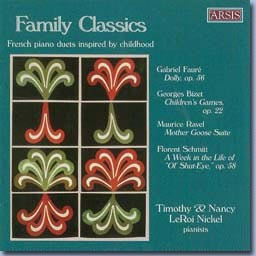Arsis Audio / ce / CD137
Family Classics: French piano duets inspired by childhood
$15.95
Scroll down for Related Items listings.
Music by Faure, Bizet, Ravel & SchmittTimothy & Nancy LeRoi Nickel, pianists The French joie de vivre seems to include all aspects of life - food, wine, language, culture, and even childhood. The notion of childhood really began as a nineteenth-century concept and French romantic composers did their part to capture the innocence and infectious spirit of the young. Fairy tales by Charles Perrault and Hans Christian Andersen were a constant source of inspiration, along with depictions of animals, games played perhaps in the Tuilerie Gardens in Paris, cradle songs, and other tender and domestic moments. Georges Bizet's Jeux d'enfants marks the beginning of French piano duet music as a genre in 1871. During the next thirty years, many French composers followed his lead, including Gabriel Fauré and his students Maurice Ravel and Florent Schmitt, in creating original pianistic masterpieces inspired by childhood experience for two pianists to play at one instrument. Fauré's Dolly Suite was inspired by and dedicated to Mademoiselle Hélène Bardac, whose anglicized name was Dolly. She was the daughter of Fauré's good friend, the singer Emma Bardac, who later became Debussy's second wife. Fauré presented the opening cradle song to Dolly on her first birthday in 1893, although the music had been written some thirty years earlier. The second piece of the suite was a gift for Dolly's second birthday and has often appeared under the feline-inspired title Miaou. The pianist Marguerite Long, who knew both Fauré and the Bardac family well, made it clear that this is not a portrait of the family cat but rather a portrait of Dolly's older brother Raoul, whose very proper name - Messieur Raoul - was too much for Dolly to pronounce correctly. Likewise, the fourth section, presented on her fourth birthday, is not a "Kitty-Waltz" but a waltz for Dolly's dog Ketty. The Spanish Dance that brilliantly concludes the work was inspired by Dolly's favorite bronze statue of a horse. The third section, a stroll in Dolly's garden, and the fifth section entitlted "Tenderness" reveal all the rich, elegant, unexpected harmonies and counterpoint of Fauré's style. The suite was completed in 1896 and has been orchestrated and adapted for other instruments. Georges Bizet was a virtuoso pianist whose chose, instead, to compose for the operatic stage. Luckily, he left one undisputed masterpiece for the piano - his set of twelve Children's Games for one piano, four hands. Bizet preferred the genre titles for the pieces, such as reverie, impromptu, march, and nocturne, which he used in the original edition. However, the pieces are clearly descriptive: the undulating swing, the spinning top, the volley of the badminton shuttleclock, the blindfolded person goping and stumbling about, and leapfrog played directly on the piano keyboard, for example. These charming Children's Games were very popular when they first appeared and served as models for later French composers. Bizet's berceuse "The Doll could have been the inspiration for the berceuse which begins Fauré's Dolly Suite and the duo, an intimate talk between the Little Husband and Little Wife, looks ahead to the conversation between Beauty and the Beast in Ravel's Mother Goose Suite. Bizet orchestrated five of the Games, published under the title of Petite Suite. Ravel wrote his Mother Goose Suite in 1910 for Jean and Mimi Godebski, the children of a good friend of his who maintained a celebrated artistic "salon" in Paris. The first two pieces are based on familiar fairy tales by Charles Perrault, first published in 1697. The simple pavane for the Sleeping Beauty of the forest has all the enchantment of the spell that put the princess and her entire court asleep for a hundred years. The changing meters at the beginning of Tom Thumb suggest just how lost Tom is in the forest. A cuckoo's song is heard as the bread crumbs Tom leaves to mark his trail are pecked at and eaten by birds. Using mostly the black notes on the piano, Ravel paints a vignette of the miniature Empress of the Pagodas taking a bath accompanied by her musicians playing on stringed instruments the size of almond nut shells. The conversation between Beauty and the Beast is set as a waltz. Beauty speaks first in the treble followed by the Beast in the bass. Their song and dance becomes gradually more animated with the two themes combined until, with a white-note glissando, a kiss turns the Beast into a prince and Beauty takes up his song. The fairy garden has no specific story. Instead it distills the nature of fairy tales into pure enchantment with everyone living happily everafter. With the exception of Franz Shubert, no composer has written as extensively and well for the piano duet medium as Florent Schmitt. Although Schmitt's music is not well-known outside of his native country, he was a celebrated and influential composer and critic in France during the first half of the 20th century. His Week in the Life of Ol' Shut-Eye is based on a series of seven stories, one for each day of the week. They were written by Hans Christian Andersen and told to a little boy named Hialmar by a character resembling the Sandman. This "Ol' Shut-Eye" sprinkled sand in Hialmar's eyes to put him asleep, opened a colorful umbrella over his bed and shared the stories excerpted as follows: --Timothy Nickel
Total playing time: 74"00" Gabriel Fauré Dolly, op. 56 1. 2. Messieu Aoul 3. Le Jardin de Dolly 4. Ketty-Valse 5. Tendresse 6. Le pas espagnol Georges Bizet Jeux d'enfants (Children's Games) , op. 22 7. L'Escarpolette (The Swing), rêverie 8. La Troupe (The Top), impromptu 9. La Poupée (Merry-Go-Round), berceuse 10. Les Chevaux de bois (The Doll), scherzo 11. Le Volant (Badminton), fantasie 12. Trompette et Tambour (Trumpet and Drum), marche 13. Les Bulles de Savon (Soap Bubbles), rondino 14. Les quatre coin s (Puss in the Corner), esquisse 15. Colin-Maillard (Blindman's Bluff), nocturne 16. Saute-Mouton (Leap Frog), caprice 17. Petit mari, petite femme! (Little Husband, Little Wife), duo 18. Le Bal (The Ball), galop Maurice Ravel Ma mère l'Oye (Mother Goose Suite) 19. Pavane de la Belle au bois dormant (Sleeping Beauty) 20. Petit Poucet (Little Tom Thumb) 21. Laidaronnette, Impératrices des Pagodes (Empress of the Pagodas) 22. Les e entretiens de la Belle et de la Bête (Beauty and the Beast) 23. Le jardin fé erique (The Fairy Garden) Florent Schmitt Une semaine du petit Ferme-l'Oeil, op. 58
(A Week in the Life of "Ol' Shut-Eye") 24. La noce des souris (The Mouse Wedding) 25. La cigogne lasse (The Weary Stork) 26. Le cheval de Ferme-l'oeil (The Horse of Ol' Shut-Eye) 27. Le mariage de la poupée Berthe (The Marriage of the Doll Bertha) 28. Le ronde des lettres boiteuses (The Exercise of the Lame Letters) 29. La promenade à travers le tableau (A Walk into a Landscape Painting) 30. Le parapluie chinois (The Chinese Umbrella)
Voicing/Instrument: CD Recording



